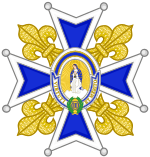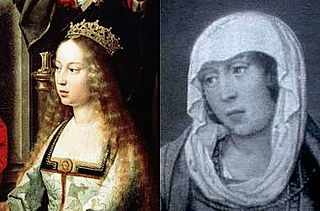Parts of this article (those related to the title of King of Gibraltar) need to be updated.(January 2024) |

The current Spanish constitution refers to the monarchy as "The Crown" and the constitutional title of the monarch is simply rey/reina de España: [1] that is, "king/queen of Spain". However, the constitution allows for the use of other historic titles pertaining to the Spanish monarchy, [1] without specifying them. A decree promulgated 6 November 1987 at the Council of Ministers regulates the titles further, and on that basis the monarch of Spain has a right to use ("may use") those other titles appertaining to the Crown. [2] Contrary to some belief, the long titulary that contains the list of over 20 kingdoms is not in state use, nor is it used in Spanish diplomacy. In fact, it has never been in use in that form, as "Spain" was never a part of the list in the pre-1837 era when the long list was officially used. [3]
Contents
- Titles associated with the Spanish Crown
- Kingdoms
- Duchies
- Counties
- Lordships
- Other titles maintained, but usually abbreviated with "etc."
- Military rank
- Hereditary orders of Spain
- Titles of the heir apparent or heir presumptive
- Principalities
- Duchy, county and lordship
- Orders of the heir apparent
- Royal titles
- Duchies 2
- Counties 2
- See also
- Notes
- References
Spain, mentioned differently in the titulary depending on which monarch was reigning, was for more than three centuries also symbolized by the long list that started "... of Castile, León, Aragón, ..." The following long titulary in the feudal style was last used officially in 1836 by Isabella II of Spain (see the account of titulary in her article) before she became constitutional queen.
Isabella I of Castile and Ferdinand II of Aragon were together described as the Catholic Monarchs of Spain. The first king to officially use a derivation of the name "Spain" as the realm in the titulary was Charles I of Spain, who used Rex Hispaniarum et Indiarum (i.e. King of the Spains and the Indies). This title was often used after his title of Holy Roman Emperor which was superior to that of king. During his brief and controversial occupancy of the throne Joseph Bonaparte, brother of Emperor Napoleon, also used a similar title, King of the Spains and the Indies, and conferred the title "Prince of Spain" to be hereditary on his children and grandchildren in the male and female line.
During the first restoration of the Bourbons, it returned to the traditional format ("of Castile, Leon, Aragon, ...") until 1837, when the short version "queen of the Spains" was taken into use by Isabella II. The singular Spain was first used by Amadeo—he was "by divine grace and will of nation, king of Spain". During the second restoration, King Alfonso XII started to use "constitutional king of Spain, by divine and constitutional grace".
Juan Carlos I, King from 1975 to 2014, did not use the style of Catholic Majesty and the other titles and honours, but did not relinquish them. [4] Like his father, King Felipe VI uses the simple title of "King of Spain", without any divine, national or constitutional reference.[ citation needed ]


















